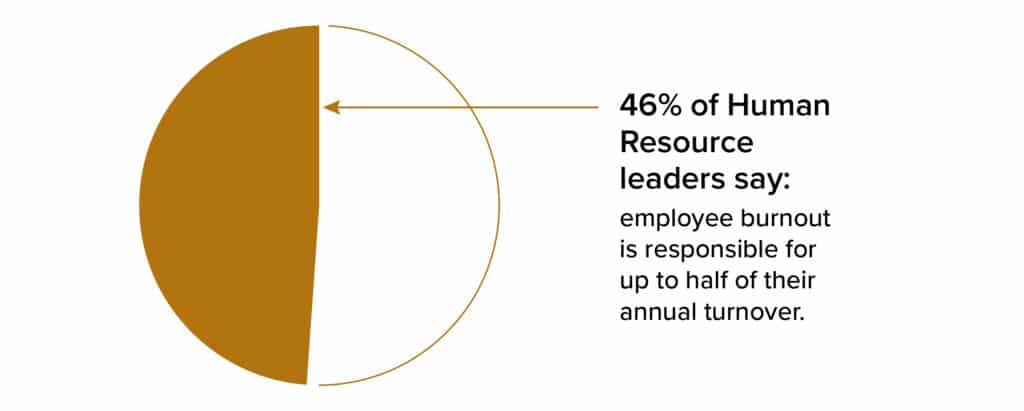
25% of employees plan to quit post-pandemic, and the majority cited burnout as the main reason.
How long can you hold an 8-ounce glass of water?
The first 15 minutes are a breeze. A couple of hours in, your arm starts to ache. A couple of hours after that, your muscles are burning. At the 24-hour mark, if you’ve made it that long, you’re in absolute agony.
Stress is like holding a glass of water; the longer you carry it, the heavier it becomes. With each passing moment, your grip on the glass weakens.
You need help!
And right now, so do your employees. As a matter of fact, your organization’s post-pandemic success hinges on it.
In this article, you’ll discover how to help your pandemic-weary employees by effectively combating burnout.
COVID-19 Burnout: Why Organizations Should Care

Source: Kronos Incorporated and Future Workplace Employee Engagement Series Study, conducted pre-pandemic
COVID-19 has created another type of public health crisis: 58% of employees are burned out, up 13% from the pandemic’s early days.
This matters because organizations with a high burnout rate spend more on healthcare, absenteeism, diminished productivity and turnover.
Whereas organizations that make work-life balance a priority can cut turnover by upwards of 50%. Their employees are happier and more productive — working 21% harder.
Pre-pandemic, 46% of human resource leaders said employee burnout was responsible for up to half of their annual turnover.
What will that number will look like as we progress further into 2021?
How to Help Pandemic-Weary Employees
There is one thing every pandemic-weary employee needs right now — more time.
We know what you’re thinking; this is a clever ruse to advocate increasing vacation time and paid time off (PTO) benefits.
Almost.
Time off is essential to combating burnout, but its effectiveness is contingent upon another factor.
No Vacation Nation
Just because you give employees more vacation time doesn’t mean they’ll use it.
- In 2015, employees threw away $52.4 billion worth of vacation time.
- In 2018, a record 768 million vacation days were left unused, a 9% increase from the previous year, according to research from the U.S. Travel Association, Oxford Economics and Ipsos.
Research suggests our hesitancy to use PTO and take vacations are symptoms of time poverty.
Time poverty is an expression used to describe people who have relatively little discretionary time.
In other words, employees feel like they don’t have time to take a vacation.
Are Your Employees Time-Bankrupt?
Most employees may not be time-bankrupt, but they’re definitely time impoverished.
In 2012, for example, almost 50% of working Americans reported they were “always rushed.” While 70% said they “never” had enough time. By 2015, more than 80% of working Americans reported they were constantly time-strapped.
Even pre-pandemic, most people sprinted from the moment their feet hit the floor in the morning until their heads hit the pillow at night.
If it’s not work, it’s kids; if it’s not kids, it’s household chores, and if it’s not chores, it’s caring for older family members like aging parents.
Time poverty is a lot like the 8-ounce glass of water: what becomes unbearable isn’t the weight of any given day; instead, it’s the cumulative effect of all the non-stop days strung together.
Benefits to Beat COVID-19 Burnout
“Time-related” benefits can save companies billions of dollars a year in healthcare, turnover and productivity costs because they decrease stress and increase personal happiness, according to Harvard Business School professor Ashley Whillans’ groundbreaking time and happiness research. She shared in an interview:
Time is one of our most valuable resources that we often squander — we often don’t think it’s as important as it is. By focusing on non-time benefits, [employers] may be doing employees a disservice, trying to cater to the benefits they think will make people happier but don’t necessarily lead to better job satisfaction.
As a matter of fact, Whillans found that time-related benefits have more of an effect on job satisfaction than tens of thousands of dollars in additional salary.
Time-Saving Benefits
Organizations can’t make a day longer than 24-hours, but they can manufacture time for employees by investing in benefits that lighten the load. These include resources for employees to outsource tasks that take up personal time like errand running, grocery shopping, car maintenance, oil changes, vet visits, carpooling, dry cleaning, and other household chores.
COVID-19 Burnout & Working Parents
Another excellent way for organizations to get ahead of COVID-19 burnout is to focus on benefits that help working parents. This is as true today as it was before the pandemic.
Interestingly, only 24% of employers believe caregiving influences their workers’ performance. However, 80% of working parents say their responsibilities at home negatively impact their productivity, and 32% of working parents have left a job because they couldn’t balance work and family duties.
Yet only 4% of organizations offer programs and services that directly help employees offload personal errands and household tasks.
An easy and cost-effective way to even the playing field for working parents is by offering resources for them to outsource time-sucking tasks.
Learn what working parents really need from employers.
As we move past the pandemic, ask yourself what resources your employees need “to get back to business as usual” without sacrificing their mental and physical health.
In the long run, both your employees and your bottom line will thank you.
Takeaways
- Organizations that reduce burnout will be at an advantage by avoiding a post-pandemic mass employee exodus.
- Time-saving benefits reduce burnout by giving employees the gift of more time.
- When employees’ day-to-day lives are more manageable, they’re more likely to utilize vacation and PTO, which further drives down the incidence of burnout.
- Time-saving benefits are beneficial for working parents and caretakers who desperately need extra support.


